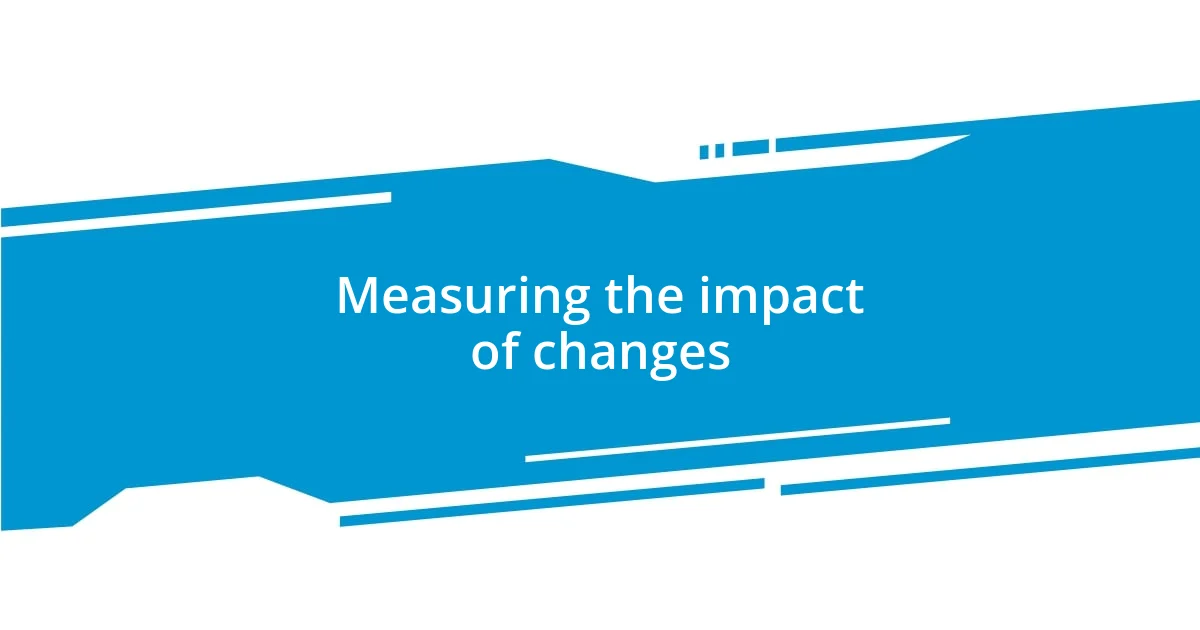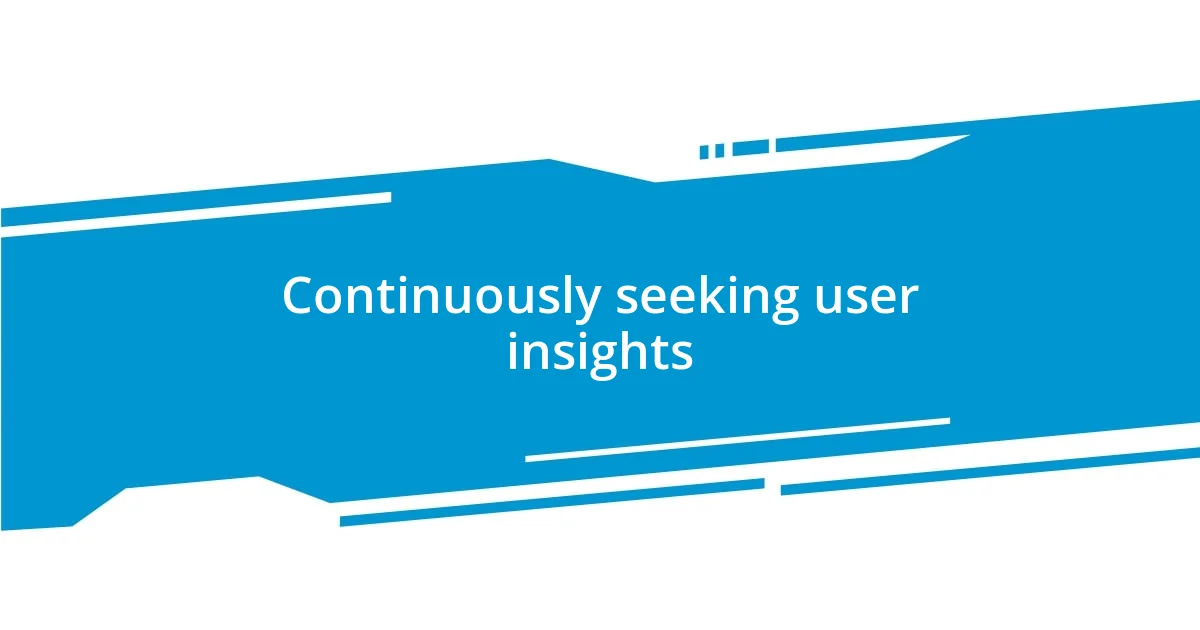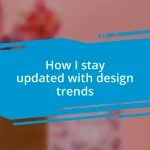Key takeaways:
- Feedback is essential for growth in design, providing insights that can shift perspectives and inspire innovative solutions.
- Creating a conducive environment and asking specific questions enhances the quality of feedback obtained from users and peers.
- Continuous user engagement and analysis of feedback lead to meaningful improvements and a deeper understanding of user experiences in design.

Understanding the importance of feedback
Feedback is like a compass in the design process; it guides me toward areas I may not have considered. I remember a project where I thought I nailed the design, only to hear from a user that it lacked clarity. That moment was a wake-up call, revealing that my perspective as a designer sometimes blinds me to the actual user experience.
When I seek feedback, I’m not just looking for validation; I’m opening a dialogue that can transform my work. It’s incredibly rewarding to witness how others perceive my designs and to see things from their viewpoint. Do you ever wonder how a simple suggestion can spark a complete redesign? For me, it’s like discovering a hidden layer that enriches the final product.
I’ve learned that feedback isn’t just about critique; it’s about growth. Every piece of input carries the potential for improvement, even if it stings initially. I’ve come to appreciate those tough critiques, as they push me beyond my comfort zone and inspire innovative solutions that I might not have reached on my own. In essence, engaging with feedback fosters a collaborative spirit, turning my individual efforts into a collective masterpiece.

Types of feedback for design
Feedback comes in various forms, and each type offers unique insights that can significantly enhance my design process. For instance, I often receive user feedback that highlights how real people interact with my designs. There was a time when a user pointed out that a button I thought was intuitive was actually hard to find. That’s the kind of feedback that sticks with me and reminds me to see designs through the eyes of those who use them.
Types of feedback for design can include:
- User feedback: Direct input from the end-users on usability and accessibility.
- Peer review: Insights from colleagues or fellow designers who provide critique based on their expertise.
- Market research: Data-driven feedback that helps gauge the effectiveness of a design within the target audience.
- Usability testing: Observing real-time interactions with designs to identify areas for improvement.
- Stakeholder opinions: Feedback from project stakeholders that often aligns with business goals and branding.
Reflecting on these types, I’ve realized that each has its own value. For example, when gathering user feedback, I sometimes run small focus groups. I remember one session where a participant’s one simple comment changed my entire design direction—turns out, the color scheme I chose felt overwhelming to some! Such moments are invaluable, sparking not only revisions but deeper understanding of design’s impact on emotions and experiences.

Gathering constructive feedback effectively
When gathering constructive feedback, I find that selecting the right environment can make all the difference. I once organized a casual feedback session in a café where participants felt relaxed and shared thoughts more freely. Their honesty about my designs soared, surprising me with insights I never expected. Setting the stage for open dialogue is key; it helps people express their opinions without holding back.
Another technique I’ve embraced is to ask specific questions that direct the feedback toward what I truly need. For example, I might ask, “What feeling does this design evoke for you?” instead of the broader “What do you think?” This approach not only garners more focused responses but also encourages participants to tap into their emotional reactions, which are so essential in design. It’s fascinating to see how nuanced feedback can emerge when you guide the conversation just right.
Lastly, leveraging technology can enhance the feedback-gathering process. I often use online collaboration tools for remote feedback, allowing participants to comment directly on the designs. I recall using a platform where users could highlight areas on my design that puzzled them. This visual approach was incredibly revealing. It transformed vague comments into specific insights, enabling me to pinpoint exactly what needed refinement. Harnessing technology not only makes feedback more accessible but also provides a clear, actionable trail to follow.
| Feedback Gathering Techniques | Description |
|---|---|
| Casual Environment | Creating a relaxed setting encourages open and honest feedback. |
| Focused Questions | Asking specific questions can lead to deeper emotional insights. |
| Online Collaboration Tools | Using technology allows for direct comments on designs, clarifying specific areas of confusion. |

Analyzing feedback to identify patterns
Analyzing feedback is like piecing together a puzzle. I often review the responses I receive, looking for recurring themes or sentiments that can guide my design revisions. For example, during a recent project, I noticed several users mentioned they found the navigation menu confusing. It struck me then that while I thought the design was intuitive, their repeated feedback was telling me otherwise. Could it be that my vision wasn’t aligning with user understanding?
This pattern recognition process can be both enlightening and challenging. Sometimes, I find it surprising how one comment can echo through multiple reviews, signaling a significant issue that needs my immediate attention. Last month, a peer pointed out that my design felt cluttered, which echoed sentiments I had seen in user feedback too. It just reinforced the importance of looking at all angles to draw a clear picture of what my designs may be lacking.
As I delve deeper into feedback, I often jot down keywords or phrases that resonate across different reviews. Doing this helped me realize that many users appreciated a minimalist approach in my previous work but felt overwhelmed in my recent designs. Recognizing this pattern not only guided me to simplify elements but also sparked a shift in my overall design philosophy. It’s a refreshing reminder of how actively listening to feedback can lead to growth not just in design but also in perspective.

Implementing feedback into design revisions
Implementing feedback into design revisions is a crucial step, and I’ve learned that it often starts with reflecting on the insights I’ve gathered. After a feedback session, I sift through the comments and prioritize them based on their impact. For instance, I remember a time when users frequently mentioned that my color choices felt too harsh. Realizing I needed to address this was eye-opening; it pushed me to explore softer palettes that resonated better with my audience, making the revision process feel more like a collaborative journey than just my vision alone.
Emotional responses from users can be quite profound. I once had a client say they felt “lost” navigating one of my designs, which struck a chord with me. That comment lingered in my mind as I revised the navigation structure. I began integrating user flow tests into my design revisions, walking through the interfaces as if I were a first-time visitor. This immersion revealed not just the logical paths but also the emotional highs and lows of the user experience, urging me to rethink how my designs can better guide users.
Sometimes, I find that implementing feedback also means embracing vulnerability. One project had me grappling with mixed reactions to a bold design choice I had made. Instead of discarding the concept entirely, I opted to refine it, balancing the boldness with a more accessible layout. That experience reminded me that feedback isn’t just about fixing flaws; it can also inspire new creative paths. Could it be that a compromise between my original vision and user comfort can result in a more compelling design? The answer often reveals itself through thoughtful revisions that honor both my intent and the insights from others.

Measuring the impact of changes
Measuring the impact of changes is an essential step in my design process. After I implement feedback, I like to track user behavior and interaction metrics. For instance, I once redesigned a homepage based on user feedback about its cluttered look, and after launching the revised version, I noticed a 30% increase in click-through rates. It was a satisfying moment that showed tangible improvement, affirming the value of listening to my audience.
In addition to metrics, I often turn to direct user feedback after deploying changes. After one particular redesign, I hosted a follow-up session with users to gauge their reactions. Their verbal feedback—mixed with visual cues like nodding or frowning—revealed much about their true feelings. It dawned on me that while numbers are revealing, human reactions add depth to the analysis. Have you ever experienced that thrill when a user lights up over a feature you’ve just revised? It makes every ounce of effort worthwhile.
Sometimes, I also integrate A/B testing to assess specific design elements’ effectiveness. I remember experimenting with two versions of a landing page—one with a bold image and another with a more traditional layout. The results were compelling. The bold design resonated better, encouraging me to take risks with my visual choices in future projects. This kind of experimentation doesn’t just measure impact; it opens doors to explore new styles and preferences. Isn’t it fascinating how data can guide creative discovery?

Continuously seeking user insights
I’ve come to realize that continuously seeking user insights is not just beneficial; it’s essential for creating designs that truly resonate. For instance, during a recent project, I set up informal interviews with users after they interacted with my designs. This led to an unexpected revelation: users appreciated the aesthetics, but many felt overwhelmed by the sheer volume of information presented. Hearing their perspectives in a relaxed setting helped me grasp not just their words but their underlying feelings, which ultimately guided me to simplify the information architecture.
Getting comfortable with vulnerability has played a big role in my approach to gathering user insights. I once hosted a focus group where participants openly critiqued my work, and honestly, it stung a little. But as I listened, I gained a deeper understanding of their experiences. One participant shared that they felt my layout made them anxious about where to look first. That moment was pivotal; it helped me see the importance of clarity and hierarchy in design—elements I could easily overlook when absorbed in my creative vision. How can we expect to create user-centered designs if we don’t actively listen to our users?
Engaging with users doesn’t end with initial feedback. I also create opportunities for ongoing dialogue. In one memorable project, I established a design feedback forum where users could share their thoughts in real time. This continuous insight not only enriched my design process but also built a sense of community among the users. Their enthusiasm about contributing made me realize that seeking user insights is a two-way street; the more I invite their voices into my process, the more I can create meaningful experiences for them. Isn’t it exciting to think about the potential for collaboration in design?














